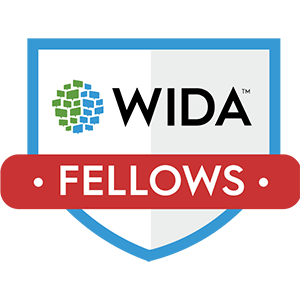December 2021 Featured Educators: WIDA Fellows on creating powerful learning environments

In this edition of Featured Educator, we share highlights from the 2021 WIDA eConference session, “Creating Powerful Learning Environments: A WIDA Fellows Panel Discussion.” During the session, some of the WIDA Fellows talked about the important lessons they learned this year and how they find and create joy in the classroom.
So that we’re all on the same page (pun intended), the WIDA Fellows are a group of 20 expert teachers from 14 states in the WIDA Consortium. They work collaboratively with WIDA professional learning specialists to enhance the development of WIDA professional learning products and services.
The WIDA eConference session featured the following WIDA Fellows:
- Sonya Bertini, Vineland, New Jersey
- Ceci Estes, Spearfish, South Dakota
- Maggie Gavello, Winchester, Virginia
- Demitrica May, Phenix City, Alabama
- Suzy McIntyre, St. Cloud, Minnesota
- Catriona Moore, Durham, North Carolina
- Nicole Ponti, Manchester, New Hampshire
- Dennise Torres, Naperville, Illinois
- Vilanha Turner, Andover, Massachusetts
Let’s look at what the WIDA Fellows had to say about things like teaching during a pandemic, honoring student identity in the classroom, finding hope, healing and social justice, and their take on professional development.
The following questions and answers have been lightly edited for clarity and length.
Teaching during the 2021 academic year posed different challenges. What was most difficult for your multilingual learners? How did your multilingual learners experience success in your classrooms?
Suzy: My challenges last year were pretty much the same as the year before: I had to figure out which families didn't have internet access or computers. Another big challenge was how to get my eighth graders to stay engaged. The positives were that our speaking scores on ACCESS for ELLs increased. And I offered my eighth graders the opportunity to work with me on the National Public Radio podcast challenge. I had one student take me up on that. From thousands of entries, she ended up being one of the semifinalists in the country. Even though she moved back to Kenya for a little bit, her father was still here so we were able to FaceTime with her. I think the smile on her face will forever be embedded in my memory because I was able to tell her that they heard her, they heard her voice.
Catriona: Just like Suzy, our students had challenges with technology and access to the internet. I like to think of these challenges in terms of what we were forced to do and what we chose to do with it. We were forced to be on Zoom and the challenge was how do we figure out new ways to build intentional community. I think about the positives of that: We launched fully into co-teaching and co-planning, both with other English language development teachers and classroom teachers – and teachers of students with special needs. We constructed text every day with students. One of the other positives that came of that was our writing scores were actually pretty good on ACCESS this year. I think it came from that daily writing.
A powerful learning environment is one in which learners can bring their true self in order to share and grow with others. It is a given that a student’s identity isn't something that they leave at the door. How did you nurture multilingual learners’ dynamic identities?
Dennise: I think that when we have a passion for teaching and a passion for getting to know our students as more than just a test score, or a struggling reader, or even a proficient reader, we start to see them as individuals with a great personality and identity. This allows us to build a relationship with our students. It's through these relationships that we begin to nurture their identity. Then, the question to me is “how do you build these relationships so that the student can feel like they belong, and they can be themselves in your classroom without leaving their identity at the door?” I think a way we can do this is taking each child as a whole and knowing that they have a family – a family at home, or even miles away – and that family is part of that student.
Vilanha: Building relationships with our multilingual learners is so important. We can begin to build these relationships and nurture identity by learning how to properly pronounce our students’ names. My name has always been difficult for people to pronounce, so I'm a little sensitive to this. I think when we take time to learn their names, it tells our students that their name is an important part of who they are and where they're from. If we don't acknowledge the correct pronunciation because it's too difficult, or too unfamiliar to us, I think it can really affect how our students feel in our classrooms. At the beginning of the school year, one activity that we often do is to read “The Name Jar.” I think this is a great story to get students talking about the importance of our names.
In what ways have you enacted the belief that students’ language, culture and experiences, are rich resources on which to build in their practice. How have you challenged the notion of a culture of poverty?
Sonya: It has always been my fundamental belief that a student’s first language, culture and experiences are assets. Because I speak my students’ language, Spanish, I feel that my students know that they can speak their language in the classroom. And that they can translanguage. For example, if we're discussing a novel, I let the students’ express ideas to me in Spanish. This gives them confidence. If I want them to reflect on a question, what I want to know is have they understood that point in the novel, plus what did it mean to them and can they make a connection to it. I know best when they are able to express themselves in their language.
Ceci: Piggybacking on what Sonya said about translanguaging. Right now, I work in two districts and teach high schoolers. Every year we do a project on “how did you get here, where did you come from, what was your timeline to get here.” I’m surprised every year how many people stop in the hallway and look at our presentations. As far as challenging the notion of a culture of poverty, I'm going to go back to what Dr. Nieto said “ideology: what is our idea, compared to what we want.” Are we pushing our ideas or their ideas?
What roles do advocacy, hope, healing and social justice play in creating powerful learning environments for your students?
Maggie: I look back at a scene in “The Blind Side” when the coach stands up for Michael. Once Michael sees the coach stand up for him, he knows that he has somebody at his back who is willing to do anything. I've seen that from some of my kids, they know that I am going to go fight for them. I also work with them on a graduation plan. Once they start checking off those boxes, they can see the light at the end of the tunnel. There's hope and there's excitement that they're going to make it to graduation. One of our Spanish world language teachers does this awesome activity with students that have crossed the border. She has them tell their border crossing story, in Spanish, to her more advanced Spanish classes. There's an almost healing quality to it because people listen and care and want to reach out.
Demetrica: My students and parents know they can always email, call or text me. I want my students to know that they matter. I've always been like that because when I was in school, I remember being in places where I felt like I didn’t matter to many people. I never want that for my students. My students are bright, they're capable and they can learn, and I will always be an advocate for them. I had a student tell me that I was her teacher mom. That meant a lot to me because when she was in school, she felt safe. And she knew that someone had her back. I will always be a teacher that has my students’ back because they have something that is special. I tell them every day, “you bring something to the school that many do not; you have something to share.”
Whether it’s an event you led or attended, describe two or three key elements of a powerful learning environment for educators.
Dennise: A few years ago, I provided professional development for some of our classroom assistants to discuss guided reading. Instead of going into what a guided reading plan looks like, I thought, let's take it back and explain why we assess students, how we assess students, how we read the data, how we create the groups and why we have these components of literacy. This helped everyone see that guided reading plans are strategically planned out. Another key to creating a powerful learning environment is listening to what teachers want and what they need – at the moment.
Nicole: We want to make sure that participants, just like our students, are engaged. That it's relevant to the content that they're teaching but also relatable. I find using either graphics or comics or things like that to help break the ice and also keep the content fresh and not dry.
What advice would you give to fellow educators about serving multilingual learners?
Sonya: To enjoy them! Recognize that you're in a position of real privilege to be in a classroom with students from such a variety of backgrounds, life experiences and languages.
Maggie: Celebrate the moments! All the little things are so important.
Vilanha: Be aware of the idioms we use every day that can be confusing to our multilingual learners.
Demetrica: Never stop learning and growing. Every year is a different year. Embrace the change.
Nicole: Invite the parents early and consistently throughout the educational process. That way our families feel welcome!
Dennise: Don’t be quick to judge. Remember that parents are also struggling and they're doing the best that they can with their children.
Ceci: Set high expectations for students, but make sure that they are not hurried ones. We all know that language learning takes time.





